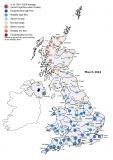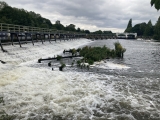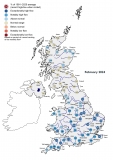Glossary
This page provides definitions for some terms commonly used by the NRFA. Abbreviations can be found here.
| AMAX | The Annual Maximum (AMAX) series contains the largest observed flow (in cubic metres per second, abbreviated to m3⋅s−1 and sometimes also referred to as 'cumecs') in each water year. |
| AMAX1 | The AMAX1 is the highest largest maximum obserrved flow in the AMAX series. |
| Annual exceedance probability (AEP) | The probability associated with a return period (RP). An event with a return period of 50 years has an AEP of 1/RP (0.02). |
| Afflux | The rise in water level immediately upstream of, and due to, an obstruction. |
| Aquifer | A rock formation containing groundwater that can be abstracted economically in useful quantities. |
| Artesian well | A shaft, or more commonly a borehole, within which, when the aquifer is penetrated, water rises within the well to a level above the top of the aquifer, i.e. above the base of the confining layer. The term is usually reserved for wells that naturally overflow at the ground surface; where the water level rises, but does not reach the ground surface, the term sub-artesian is sometimes used. |
| Backwater (curve) | The profile of the water surface upstream when its surface slope is generally less than the bed slope. The backwater curve generally occurs upstream of an obstruction or confluence. |
| Borehole | A well constructed by machinery, usually less than one metre in diameter. Usually constructed vertically, but incline boreholes are occasionally constructed. |
| Broad-crested | A weir of sufficient breadth (in the direction of flow) such that the critical flow occurs on the crest of the weir. The term long-crested is sometimes also applied to such structures. |
| Cableway | An assembly of winches and ropes and a carrier for placing the current meter at any desired point in the cross section. |
| Calibration | The establishment of a discharge relationship (or rating) with the measured stage values. Sometimes used as a synonym for the stage-discharge relation. |
Casing | See 'Lining'. |
| Catchment Monthly Rainfall | A time series of the total rainfall averaged over the catchment in millimetres for each month. |
| Compensation | A minimum flow which a water authority is under obligation to discharge into a watercourse as a condition of carrying out their undertaking. Commonly the obligation relates to the maintenance of a discharge rate below a reservoir. The term ‘residual flow’ is preferred by some authorities. |
| Compound weir | A weir containing two or more sections, which may be of different types, each section normally having a different height. |
| Confined aquifer | An aquifer in which groundwater is held under pressure by a confining layer. |
| Confining layer | An impermeable rock formation that immediately overlies an aquifer, and which may contain water in the latter under pressure. |
| Control | The physical properties of a channel, natural or artificial, which determine the relationship between stage and discharge at a location in the channel. |
| Crest-tapping | A means of measuring the pressure head near to the crest of a weir – the rating of this head to the upstream measured head can be used to determine the reduction factor necessary when flows are non-modular. |
| Critical flow | The flow in which the total energy head is a minimum for a given discharge; critical flow conditions are created by the installation of most standard weirs and flumes (as well as by natural obstructions and constrictions). |
| Dates | On the NRFA Peak Flow data pages, all dates are in the format DD/MM/YYYY. |
| Datum | The datum is defined as gauge zero, the level (in mAOD) at which the gauging station records zero flow. |
| Depth of approach | The depth of the upstream bed at the tapping point below the lowest point of a weir crest. |
| Drawdown curve | The profile of the water surface where its surface slope exceeds the bed slope, for instance, immediately upstream of a weir or flume. |
| Drowned | A circumstance in which the upstream water levels at a gauging structure are affected by the downstream water levels (and the ‘modular’ stage-discharge relation no longer applies). |
| Flow | The water flow in cubic metres per second (cumecs). |
| Flume | An artificial channel with clearly specified shape and dimensions which may be used for the measurement of flow. A standing-wave flume, for instance, contains a constriction which causes the flow to change from sub-critical to super-critical and in which the measurement of upstream water level (alone) allows the discharge to be computed. |
| Freshets | The periodical release of discharge rates over and above the basic compensation flow. These artificial floods are intended to benefit the aquatic environment, particularly fisheries. |
| Gaugedboard | A device with a graduated scale installed at a gauging station for measuring the level of water relative to a datum. Gaugeboards can be either vertical or inclined. |
| Gauged Daily Flow | The Gauged Daily Flow is the mean river flow in cubic metres per second (abbreviated to m3s-1 and sometimes also referred to as 'cumecs') in a water-day, (09.00 to 09.00 G.M.T.) or, where indicated, a calendar day. |
| Groundwater | Sub-surface water contained within the saturated zone. |
| HOST | A delineation of UK soil types according to their hydrological properties to produce the 29-class Hydrology of Soil Types (HOST) classification. |
| Hydraulic jump | The sudden change of flow from super-critical flow to sub-critical flow. The transition is marked by a standing-wave. |
| Hysteresis | The effect on the stage-discharge relation at a gauging station subject to variable water surface slope where, for the same gauge height, the discharge on a rising stage differs from that on a falling stage. |
| IHDTM | A 50m grid Digital Terrain Model (DTM) derived by CEH Wallingford (previous the Institute of Hydrology (IH)). The IHDTM allows drainage paths (which are not necessarily the same as watercourses shown on a map) to be derived and used to form indices (e.g. DPLBAR) which are then applied to flood estimation equations. |
| Influent stream | One which flows above the water-table and contributed to it by natural leakage through the bed of the channel (sometimes termed a ‘losing’ stream; conversely a ‘gaining’ stream has its flow naturally augmented by inflow through the bed or banks). |
| Invert | The lowest part of the cross-section of a natural or artificial channel. |
| Lining | Boreholes and wells are normally completed with a lining to protect their structural integrity. The lining may be plain (sometimes referred to as a casing) or slotted (a screen). A plain lining may isolate, or partially isolate, observed water levels from the influence of near-surface aquifers. |
| MORECS | Meteorological Office Rainfall and Evaporation Calculation System. Produces SMD values for grid squares of 40km by 40km. |
| Modular limit | The submergence ratio when the flow just begins to be affected by the downstream level. |
| Nappe | The jet formed by the flow over a weir. A clinging nappe is one held in contact with the downstream face of a weir. |
| Observation well | A shaft or borehole used for observing groundwater head or quality. |
| Permeability | The ability of material to allow the passage of a fluid. |
| Piezometric head | The surface that represents the static head of the groundwater surface in a confined aquifer; in practice, the static head is taken to be the water level measured in a well penetrating a confined aquifer. |
| Potentiometric | The surface that represents the static head of the groundwater surface in both confined aquifers and water-table aquifers (i.e. where the water or pressure surface is at atmospheric pressure). This terms includes piezometric surface and water-table. |
| POT | The Peaks Over Threshold (POT) series contains all peak flows that are greater than a given threshold flow, the threshold is generally set to include an average of 5 events per year. |
| Protected | On the NRFA Peak Flow data pages, flows marked as ‘protcd’ have been specified and are 'protected' from being overwritten. |
| QMED | The median annual maxima flood. QMED has an annual exceedance probability of 0.5 and a return period of 2 years. |
| Rank | On the NRFA Peak Flow data pages, rank 1 is the highest flow on record. Ranks in the AMAX pages should be regarded as only indicative, because in some cases flow values have been changed after the ranking was determined. |
| Ref | On the NRFA Peak Flow data pages, this refers to the rating number on the ratings page. |
| Return period | The measure of the rarity of a flood, defined as the average interval (in years) between the occurrence of floods that exceed it. |
| Rising | A term used particularly in South West England for a continuous outflow of subterranean water of such dimension as to be regarded as the emergence of a stream rather than a spring; characteristic of karstic aquifers such as the Carboniferous Limestone in the Mendip Hills. |
| Rhymer weir | A simple form of variable geometry weir consisting of fixed horizontal beams which support vertical timber posts for form a series of rectangular openings; these may be closed by means of timber gates. |
| SMD | Soil Moisture Deficit is the capacity of the soil to absorb water. Field capacity has zero SMD (i.e. saturated). The model used in the FEH allows a maximum value of 125mm. |
| Saturated zone | The part of an aquifer, normally beneath the deepest water-table, in which ideally all voids are filled with water under pressure greater than atmospheric. |
| Screen | See ‘Lining’. |
| Shaft | A well constructed by hand and generally greater than one metre in diameter. |
| Source (of data) | On the NRFA Peak Flow data pages, the source of the data is given. For example, the current digital archive, an earlier digital archive (e.g. Hydrolog, Hydpeaks), a chart (or microfiche copy of a chart), data given in the Flood Studies Report (FSR) or held by CEH. |
| Stage | The elevation of the free surface of a stream relative to a datum; sometimes also referred to as the gauge height. |
| Stage-discharge | An equation, table or formula which expresses the relation between the stage and the discharge in an open channel at a given cross-section. |
| Stilling well | A well connected with the main stream in such a way as to permit the measurement of stage in relatively still liquid. |
| Submergence | The ratio of the downstream total head (measured head plus velocity head) to the upstream total head over a weir. |
| Supressed weir | A weir whose sides are in the same plane as the open channel thus eliminating (suppressing) side contractions of the stream. |
| Thin-plate weir | A weir constructed of a vertical thin plate with a thin crest shaped in such a manner than the nappe springs clear of the crest. |
| Times | On the NRFA Peak flow data pages, all times are in Greenwich Mean Time (GMT) and in the 24 hour format HH:MM. |
| Triangular-profile weir | A weir having a triangular profile in a vertical direction in the direction of flow. The ‘Crump’ and ‘Flat V’ weirs are examples of such structures. |
| Unsaturated zone | That part of an aquifer between the ground surface and the water-table. |
| Unstable channel | Channel in which there are frequent and significant changes in control. |
| Velocity of approach | The mean velocity in an open channel at a specified distance upstream of a measuring device. |
| Velocity head | The head obtained by dividing the square of the mean velocity (in the measuring section) by twice the acceleration due to gravity. |
| Water day | On the NRFA Peak Flow data pages, all times are in 24 hour format HH:MM, with the water day running from 09:00 to 08:59 the following day. When the time is unknown, the time is given as 00:00. |
| Water level | In a groundwater context, the altitude (or depth) of the water surface as measured in a well. |
| Water-table | The surface of a groundwater body at which the water pressure is atmospheric. Unless the water-table is coincident with the ground surface, an unsaturated zone will be present. |
| Water year | On the NRFA Peak Flow data pages, AMAX data are presented for water years, from 01 October to 30 September. |
| Well | A term used to include both shafts and boreholes although occasionally used for shafts only. |
| Wrack marks | Line of debris (often vegetation) left following a flood; provides a guide to the maximum river level. |



